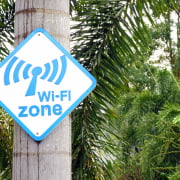How Companies Use AI Driven WiFi
As an IT person for a mid-market sized company, you’re doing what you can to provide an experience that meets today’s business demand. More than just keeping the lights on, you want to help the company innovate. Or, using today’s buzzword, you want to be a part of digital transformation.
This looks like providing Wi-Fi in branch offices so people can use mobile devices anywhere from conference rooms to the break room. It’s adding Internet-of-Things (IoT) devices to better regulate lights, thermostats, and cameras. Maybe you considered launching an app and smart devices to help navigate customers to certain products and receive coupons. This is really just the beginning.

The Challenge for IT Teams
Taking the company through digital transformation is the ideal scenario, but you’re already tied down with operational tasks. You receive hundreds of help desk tickets a month. Many are around Wi-Fi issues. You’re removing malware-infected devices off the network daily. When something stops working, you have to go through backlogs of data through multiple systems just to find out where something went wrong. Was there a misconfiguration of a firewall rule? Is it a switch or access point issue?
You already have a full-time job managing the normal day-to-day needs of those using the network. How could you possibly add more devices, applications, and services to the network while securing and managing all of it?
It’s for these reasons that mid-sized companies are adopting artificial intelligence (AI). This helps IT teams simplify network management and security while giving them the foundation for digital transformation.
How Mid-Sized Companies Are Adopting AI-Driven Wi-Fi
How are these companies rolling out AI? Fortunately, it’s easier and more budget-friendly than one may think. This is because the solution includes a cloud-based appliance with Wi-Fi 6 access points. Everything starts working the moment you install the access points and log into the appliance portal. The solution is called Juniper Mist.
Here’s what it does and how it’s changing IT operations from a management nightmare to a foundation of innovation possibilities.
Consolidate Infrastructure and Management Tools
To create the digital experiences we described, companies would need to purchase a third-party product called a beacon as well as access points and smart devices. Beacons allow a Bluetooth enabled device to connect to the wireless network. Juniper Mist put the antennas inside of the access points so you don’t need beacons anymore. That’s just one way you’re consolidating infrastructure.
You’re also consolidating management tools, which brings us to our next point.
Client Level Visibility
One of the main reasons for IT complexity is a lack of visibility. It’s hard to see what’s happening in the network when you’re going back and forth between different management tools trying to piece together the data into a story. There’s a management tool for the access points, firewalls, IoT devices, and so on.
With Juniper Mist, you see a high-level view of the location (i.e building, store, arena) and all the Wi-Fi connected devices to easily see patterns and movement across the environment. This is done by putting three of the Juniper Mist access points in an area for triangulation so you can see where each person (or WiFi-connected device) is standing, walking, or sitting in a building. Once the Juniper Mist access points are installed, all you have to do is sign into one application portal and see how all the devices on your network are moving and working.
For example, you can view the rumba going room-to-room cleaning floors. You can see people walking down the hallways or aisles. Each device appears as a moving dot. If a device moving from the lunchroom to the conference room is infected with malware, the dot representing it turns red and you receive a notification. Now you can click, drag, and drop to remove it before it infects more devices. This is possible because all devices using the Wi-Fi show up in this cloud-based application’s portal.
Consider how important this might be to hospitals that want to keep track of all the ventilators. Now the IT team can sign into Juniper Mist and see exactly where all the ventilators are located.
It’s not just the access points and wireless devices that populate in this portal. It’s also your switches and will soon include security. Now you have even a fuller view of the network to better analyze traffic and remediate issues.
Operational Efficiency
For those of you managing networks, you already see the operational efficiencies this would bring to your day. You can manage larger environments with fewer people and less overhead. But this solution doesn’t stop with visibility benefits. Remember, this is AI-driven. With an add-on subscription, you can have an AI assistant called Marvis.
Marvis is constantly learning about your environment.
For example, a firewall misconfiguration can throw an entire site down by stopping point-of-sale scanners, thermostats, and any other wireless devices from authenticating. This would normally take a team hours-to-days to find the problem and resolve it. Marvis finds the problem and automatically fixes it for you before it there’s a performance issue. No scrambling and little-to-no downtime.
Or, have a question about network performance? Type in a question to Marvis and receive an answer as though asking an assistant.
It’s because of these visibility and AI-driven efficiencies that some companies are moving from 200 help desk tickets a month to less than five.
In short, Marvis helps you be proactive instead of reactive.
Now that you and the rest of your team are no longer tied down with repetitive and tedious performance tasks, you can use that time and resources to innovate.
Customer Experience Innovation
Most of us in IT want to do more than keep the lights on. Innovation feels like play and is why most of us entered this field. It’s even better when our innovative play benefits everyone who interacts with the business.
For example, school districts can better manage Wi-Fi and the various education devices while securing against malware-infections that students and teachers often bring back on location. Or, use the location services to know where students are at any given time and event. Is there a fire and you want to make sure everyone evacuated? Now you can.
Hospitals can provide high wireless performance for mission-critical devices while also keeping tabs on device location at all times. For example, want to make sure a patient doesn’t walk out of the facility before they are safe to leave? Now you can track patients and notify caretakers.
Imagination becomes the limit instead of how many hours are in a day.
That’s why mid-sized companies are taking this next step in their AI strategy. They’re looking ahead to build the network they will need 5-10 years from now.
Next Steps
Curious to see this action? Select your most problematic site and let us do a proof-of-concept.
You can also join us for the Wireless Wednesday live demo where you will also see it in action.
Your team is busy managing a range of IT responsibilities. Let us help save you time and stress by and discussing what strategies and technologies can benefit your goals, operations, and budget.
Partnership
This post is brought to you by Juniper Mist. Juniper Mist is pioneering the new wireless network. The first AI-driven network makes Wi-Fi predictable, reliable, and measurable while delivering amazing indoor and outdoor location experiences.






Leave a Reply
Want to join the discussion?Feel free to contribute!